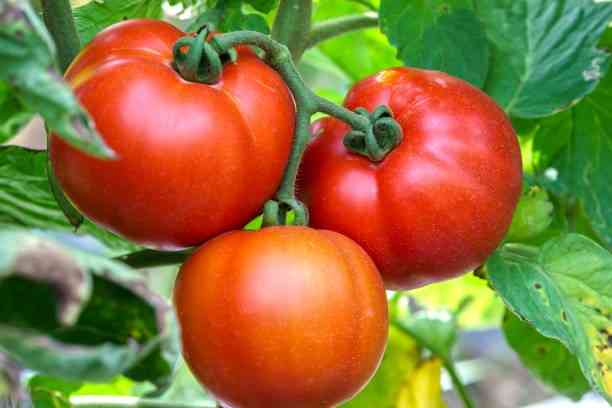Which Acid Is Present in Tomato? Health Benefits

Tomatoes are a globally acceptable base used in most cuisines in different cultures. Indian delicacies have also evolved from seeing tomatoes as a foreign cooking component to embracing them completely. Today, tomatoes are a central part of Indian gravies, curries, and other authentic flavours. Indians use tomatoes to enhance the flavor of similar spices and ingredients used to authenticate dishes. Let us look into the commonly asked question: Which acid is present in tomatoes? We’ll also discuss its health implications, nutritional value, and traditional uses in Indian households.
Tomatoes were introduced to India by the Portuguese back in the 16th century. And while they were not readily accepted, they have gradually taken over becoming one of the most important go-to ingredients in Indian dishes. Tomatoes have a special place in North India, where dishes are characterized by rich textures and complex flavours. This fruit has become a common component in most gravies and curries.
Tomatoes are well known to be a rich source of lycopene. It is a carotenoid that gives the opulent look on the ripened tomatoes. The antioxidant is vital since it provides protection to the human cell and assists in combating the free radicals to guard against illnesses. It is worth noting that processed tomatoes boast a higher content of lycopene compared to their fresh counterparts. However, consumption of processed foods is not recommended. Therefore, it is better to incorporate fresh tomatoes into your diet to harvest the full benefits of lycopene.
Besides lycopene, tomatoes contain other types of nutrients that are good for human beings. In this article, we will look at the different acids found in tomatoes, their effects, and quantity.
Which Acid Is Present in Tomato?
Ever wondered why tomatoes have tart flavor? They get their tangy taste from their acidic properties. These acids include citric acid, ascorbic acid, as well as malic acid. The acid found in abundance in tomatoes is citric acid, followed by malic acid, and finally ascorbic acid. These acids are some of the useful nutrients of tomatoes.

Citric Acid
This is the acid found in abundance in tomatoes and gives the fruit the sharp flavor. The taste that is characteristic of fresh, uncooked tomatoes is typically sour and tangy. Dishes such as pani puri fillings and kachumber salads display the strong presence of citric acid in tomatoes.
Here are some of the benefits of citric acid:
- It is responsible for energy production at the cellular level.
- Citric acid aids in iron and mineral absorption.
- Supports digestion and kidney health
- Acts as a mild preservative, extending shelf life.
One of the uses of citric acid that may not be common knowledge is that it’s one of the components used in additives to bring out the sharp taste found in some soft drinks. Citric acid has also been found to help individuals reduce the possibility of developing kidney stones. This is as a result of the citric acid binding itself to urinary calcium and reducing the saturation of urine.
Another health benefit of citric acid in the medical field is that it helps prevent the development of gout. To do this, citric acid aids the body in the excretion of uric acid, resulting in no buildup that can cause gout. Therefore, adding tomatoes to your diet may easily provide you with similar benefits.
Other sources of citric acid – Citrus fruits are natural sources of citric acid that are more popular than tomatoes. Fruits that boast high citric acid include citrus fruits like oranges, lemons, pineapples, some berries, grapefruits, and more. Vegetables are also good sources of citric acid; dark green vegetables and some peppers provide high quantities of citric acid.
Malic Acid
Malic acid has a milder sourness. Most people associate it with apples, but tomatoes carry a significant amount, too. While citric acid is known to be the most prominent acid in the fruit, malic acid is most prominent when the fruit has not yet ripened.
The following are some of the benefits of malic acid:
- Supports healthy skin
- Contributes to healthy gums and overall dental health
- Boosts exercise performance
- Helps reduce fatigue
The combination of malic acid and citric acid results in the rich and distinct taste that characterizes Indian gravies. On its own, malic acid can also be used to mask bitterness in certain dishes that have a variety of ingredients.
As an additive, there is a recommended amount that, if not used, malic acid can significantly affect product quality. Malic acid has also been used in different medical settings, such as in the treatment of liver disorders, wounds, and other drug trials for hypertension.
Other sources of Malic Acid – One of the richest sources of malic acid are apples. However, there are other natural sources such as currants, oranges, bananas, plums, grapes, cherries, papayas, mangoes, carrots, peas, potatoes, and beans. Malic acid can also be produced artificially by fermentation.
Ascorbic Acid (Vitamin C)
Lauded for its ability to produce collagen and boost immunity, vitamin C is one of the essential acids in this fruit. Nonetheless, this acid is significant in making tomatoes good for immunity and general health.
Ascorbic acid can easily be termed as the most essential acid of them all. This is due to the body’s inability to create or store vitamin C independently. Therefore, consumption of this nutrient on a daily basis is highly encouraged for good health. Vitamin C is one of the nutrients that is required daily because the body does not store it.
Benefits include:
a) Fighting Infections – Vitamin C has for years played a central role in curing common colds and flu. Vitamin C can help prevent complications like pneumonia that result from infections.
b) Stress – Vitamin C can easily be depleted when individuals don’t take good care of their health. Abuse of alcohol and drugs has also been seen to contribute to the depletion of this essential nutrient. For this reason, Vitamin C is associated with several stress-related conditions.
c) Skin Health – This nutrient is one of the best anti-aging remedies. Vitamin C is responsible for cells both on the inside and outside of the body. The antioxidant properties of vitamin C fight free radicals, preventing different types of damage to the skin’s appearance.
Other sources of Vitamin C: There are different fruits and vegetables that boast high quantities of vitamin C. Fruits like guava, tangerines, cantaloupe, strawberries, and others are rich natural sources of vitamin C. Dark leafy vegetables such as spinach, broccoli, and others are also rich in vitamin C.
How Acids Enhance Indian Cooking
There are different ways acids in tomatoes are used in Indian dishes. Some use it as a base for all the other ingredients, and others use it to tone down bitter spices that would otherwise change the flavor of a dish. Here are some of the ways acids are used in Indian cooking:
Sharpening Flavor – There are spices and herbs that cannot easily stand out in a dish unless tomatoes are added. Therefore, tomatoes are used to amplify the presence of such ingredients and bring the flavors together. Ingredients like coriander would taste different if tomatoes were not used to amplify them.
Making Meat Soft and Tender – The tomato acids help tenderize proteins in recipes with meats, making the final dish richer and easier to digest.
Balancing Flavors in Rich Dishes – Curries and gravies are typically creamy and heavy. The tomato acids provide balance that brings flavors together and makes it easier to enjoy the dish.
Tomatoes in Traditional Indian Remedies
Tomatoes have for centuries been used beyond the kitchen due to their acids and antioxidants.
i) Skin Care — The acids found in tomatoes help acne-prone skin to clear out. Apply mashed tomato on affected areas, and the acids will help tighten pores and reduce inflammation.
ii) Digestion—Tomato juice mixed with cumin is believed to aid against bloating and slow digestion.
iii) Weight loss – Rich in fiber and low in calories, tomato drinks first thing in the morning are believed to support metabolism and control appetite.
Acids in Raw vs. Cooked Tomatoes
The difference between cooked and raw tomatoes is evident in the quantity of lycopene. The tomato’s property is greatly increased when the tomatoes are subjected to heat in the cooking process. Incorporate both raw and cooked tomatoes in your diet to enjoy the full benefits that this fruit offers. The following are some of the benefits you can expect from tomatoes:
Raw Tomatoes: Higher vitamin C content – Crunch and freshness for salads – Good for detox and hydration.
Cooked Tomatoes – The lycopene content increases, making the cooked option a good source of the antioxidants.
Are Tomato Acids Suitable for Everyone?
Yes, tomato acids are suitable for everyone. However, excessive consumption can result in some discomfort, such as heartburn, in people with acid sensitivity. Another unpleasant effect that stems from excessive consumption of raw tomatoes is enamel damage.
Consumption Tip: Pair tomatoes with milk-based foods when making curries or gravies – If eating raw, ensure not to have it on an empty stomach.
General Benefits of Tomatoes

Tomatoes are loaded with nutrients such as vitamin B, E, C, potassium, flavonoids, lycopene, and acids. It is no wonder that eating tomatoes is said to have numerous health benefits. Some of these benefits include:
a) Heart – Lycopene may aid in lowering blood pressure and cholesterol, which can affect the heart. Tomatoes are also packed with other nutrients that are beneficial to heart health.
b) Eyes – Tomatoes carry substances called zeaxanthin and lutein that may be beneficial to your eyesight. In a world where we spend most of our time in front of digital devices, these two substances may help protect our eyes from the effects of the blue light.
c) Immune System – Lycopene gives tomatoes their antioxidant properties, making them able to fight free radicals. As a result, it prevents damage to the cells that can lead to serious illnesses like prostate cancer.
d) Oral Health – Tomatoes may also help with gum disease due to lycopene. However, with the acids present in the fruit, excessive consumption of tomatoes may damage the enamel. Everything done in moderation is always beneficial.
e) Skin Health – In the same way lycopene protects tomatoes from sun damage, it may help your skin too. It is not applied as sunscreen, but due to its ability to protect your cells, your sun exposure is guaranteed to have less effect. Your skin also benefits from tomatoes because of the antioxidants that fight free radicals.
Fresh vs. Canned Tomatoes
Heat reduces the level of nutrients and acids in tomatoes. Tomato is one of the few fruits that you get to enjoy benefits when raw and when cooked. Lycopene is the only tomato property that increases when the fruit is cooked or canned.
Conclusion
Indians have embraced the use of tomatoes and personalized them to make some of their most delicious dishes. We have seen which acid is present in tomato and the roles each one plays. These acids account for the tangy taste that tomatoes are known for and give them the health benefits that we all appreciate. Whether you choose to have them raw, cooked, from a can, or juiced, tomatoes are an essential component in our diet. Recipes passed down from generations have tomatoes as a significant ingredient that either enhances or balances all the flavors for a perfect dish.
Frequently Asked Questions (FAQs)
Q1: What is the main acid in tomatoes?
A: Citric acid is found in abundance in tomatoes as compared to other acids.
Q2: Can tomato acids damage my teeth?
A: In excess, yes. Their acidity can erode enamel, especially in raw form.
Q3: Does heat reduce tomato acidity?
A: Yes, cooking lowers acid levels while increasing lycopene.
Q4: Can I eat tomatoes if I have acid reflux or GERD?
A: It is best to avoid having raw tomatoes on an empty stomach. You can also wait until the symptoms pass before indulging in raw tomatoes. And while cooking them reduces acidity, it is best to avoid intake if symptoms persist.
Q5: Can I drink tomato juice daily?
A: Avoid taking tomato juice on an empty stomach. And always remember to adhere to moderation.
Q6: Is tomato good for skin?
The vitamins and proteins that keep our skin appearing young can be restored by eating tomatoes. It lessens the appearance of wrinkles, fine lines, uneven skin tone, and pigmentation brought on by aging and sun exposure.



